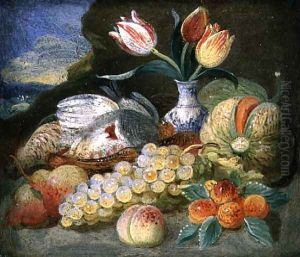Jan Thomasz. van Kessel Paintings
Jan Thomasz. van Kessel was a Flemish Baroque painter who contributed significantly to the genres of still life and flower painting. Born into a family of artists in Antwerp in 1626, van Kessel was the great-grandson of the influential painter Jan Brueghel the Elder and the son of Jan van Kessel the Elder, who was also a well-known painter. This familial connection to the world of art provided him with a fertile environment for nurturing his artistic talents. He was presumably trained by his father, though little is documented about his early education.
Van Kessel's work reflected the rich tradition of Flemish and Dutch still life painting, and he was particularly adept at depicting flowers and insects with a high degree of detail and naturalism. His compositions often featured an array of flowers in a vase, with insects scattered throughout, showcasing his interest in the natural world and its minute details. This subject matter was very much in vogue during the 17th century when curiosity cabinets and the study of natural sciences were becoming increasingly popular among the European elite.
Despite the apparent specificity of his subjects, Jan Thomasz. van Kessel’s oeuvre was diverse. He was also known for painting garland paintings, where flower garlands would surround a devotional image or portrait, often collaborating with other artists who painted the central figure. Additionally, he painted cartographic images and cityscapes, which were well-received by his contemporaries.
Van Kessel's works were highly valued during his lifetime, and he was a member of the Guild of Saint Luke in Antwerp, a typical association for artists of the period. His paintings were sought after by collectors and art patrons, both for their beauty and for their demonstration of the artist’s skill in rendering the natural world.
He died relatively young, in 1679, but left behind a body of work that continued to influence still life painters for generations. Today, his paintings can be found in major museums and collections around the world, serving as enduring examples of the Flemish Baroque style and the still life genre.
